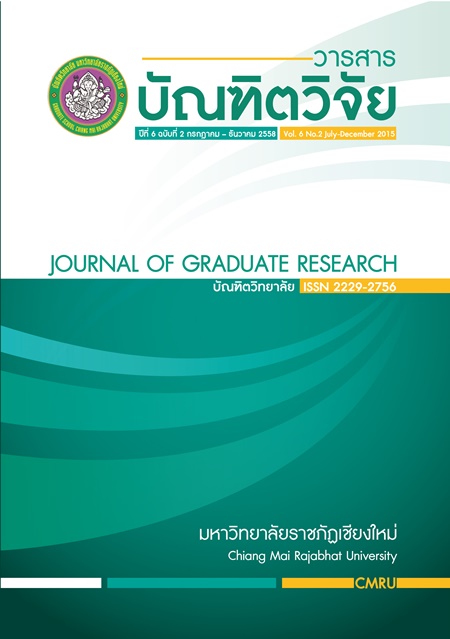The Impact of Employee’s Motivation Towards Quality of Working Life: Case Study of Chiang Mai Rajabhat University
Main Article Content
Abstract
The purposes of this study were to study the motivation factors that influenced, to study the quality of work life, and to study the relationship between the motivation and quality of work life of Chiang Mai Rajabhat University of the academic support staff. The sampling were 185 academic support staff. Questionnaire used as the tool. The data analyzed through descriptive statistics comprising frequency, percentage, mean, and standard deviation, as well as inferential statistics consisting of Independent Samples as Pearson Product Moment Correlation. The results had found that the majority of respondents were female, aged 31-35, single, Bachelor’s degree, income per month 20,001-25,000 Baht, and working experience more than 10 years in Chiang Mai Rajabhat University. The working motivation of Chiang Mai Rajabhat University academic support staff was overall at a high level = (4.08). The quality of work life of Chiang Mai Rajabhat University academic support staff was overall at a moderate level = (3.46). The personnel factors affecting to work motivation and quality of work life were gender, marital status, education level, income level, and working experience at Chiang Mai Rajabhat University. The motivation factors had positive influence on the quality of work life at .01 and .05 level of statistical significance.
Downloads
Article Details
References
จำลักษณ์ ขุนพลแก้ว. (2556). คุณภาพชีวิตการทำงาน (Quality of Work Life). สืบค้นจาก http://www.bangkokbiznews.com/home/details/business/ceo-blogs/jamlak
ณัฏฐ์กฤตา อภิโชติภพนิพิฐ. (2550). ความสัมพันธ์ระหว่างคุณภาพชีวิตในการทำงานกับแรงจูงใจในการทำงานและผลการปฏิบัติงานของพนักงาน: ศึกษาเฉพาะกรณีพนักงานของ บริษัท ไทยตาบูชิ อิเล็คทริค จำกัด. (วิทยานิพนธ์ศิลปศาสตรมหาบัณฑิต สาขาจิตวิทยาอุตสาหกรรมและองค์การ มหาวิทยาลัยเทคโนโลยีพระจอมเกล้าพระนครเหนือ).
นุชนภา โกมารทัต. (2553). คุณภาพชีวิตและแรงจูงใจในการทำงาน กรณีศึกษา: บุคลากรฝ่ายสารสนเทศในโรงพยาบาลศิริราช.วิทยานิพนธ์ ศิลปศาสตรมหาบัณฑิต สาขาวิชาการจัดการภาครัฐและเอกชน มหาวิทยาลัยศิลปากร.
บุญเจือ วงศ์เกษม. (2529-2530). คุณภาพชีวิตในการทำงานกับการเพิ่มผลผลิต. วารสารเพิ่มผลผลิต, 26.
บุญยืน สุขแสงทอง. (2555). ปัจจัยที่มีความสัมพันธ์กับคุณภาพชีวิตการทำงานของพยาบาลลูกจ้างชั่วคราว โรงพยาบาลสังกัดกองทัพบก. (วิทยานิพนธ์ พยาบาลศาสตรมหาบัณฑิต, สาขาการบริหารการพยาบาล มหาวิทยาลัยอีสเทิร์นเอเชีย).
ประสงค์ ประณีตพลกรัง และคณะ. (2543). ระบบสารสนเทศเพื่อการจัดการ. กรุงเทพฯ: ธนธัชการพิมพ์.
พิสณุ ฟองศรี. (2552). วิจัยทางการศึกษา. กรุงเทพฯ: พรอพเพอร์ตี้พริ๊น.
มหาวิทยาลัยราชภัฏเชียงใหม่. (2557). สถิติบุคลากรสายสนับสนุน. สืบค้นจาก http://www.cmru.ac.th/web55
วรพจน์ บุษราคัมวดี. (2553). การจัดการเชิงกลยุทธ์. ปทุมธานี: คณะวิทยาการจัดการ มหาวิทยาลัยราชภัฏวไลยลงกรณ์
สัมฤทธิ์ ยศสมศักดิ์. (2549). การบริหารทรัพยากรมนุษย์และแนวคิด. กรุงเทพฯ: เอ็ม ที เพลส.
สุนันทา เลาหนันท์. (2546). การบริหารทรัพยากรมนุษย์. กรุงเทพฯ: สถาบันราชภัฏสมเด็จเจ้าพระยา.


